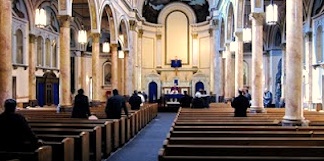Cathblog - Priest's Startling Lament for the Church
By Garry Everett
"The Church is Dead!" This exclamation is not a byte from last night’s TV news. Nor is it an utterance by a doomsday alarmist. The words ”The Church is dead” were uttered by an elderly priest – Fr Pete Chiara – on discovering that his Mass attendance had dropped to 17% of his Catholic parish population. At last count, the Australian average Mass attendance by Catholics was close to 12%. Here at home, and in many countries around the world, churches of all denominations, conduct regular sophisticated surveys which address various aspects of parish or Church life. Data from these surveys provide information for planning purposes, at national, diocesan and parish levels. In a broad sense, the data help us to measure the health of a parish, and to develop strategies and resources to maintain or improve that level of health. Between 2004 and 2007, the Willow Creek Association in the USA surveyed more than 11,000 followers with a view to learning more about the health of church life in seven member churches of various denominations. The research is published in two reports: Reveal (2007), and Follow Me (2008). Independent experts rated the research as methodologically very sound. There are a number of noteworthy aspects of this research, but space allows only three to be noted here. The first is by way of an introduction: the findings from Willow Creek challenged the prevailing wisdom derived from most other survey type research on church life. As such, the findings deserve our serious and close attention here in Australia. Specifically, there is the finding that “spiritual growth” is not dependent on “Church centredness”. Rather, the research indicates, spiritual growth is dependent largely on “Christ centredness”. Now many Catholics may think that he two terms “Church centredness” and “Christ centredness” are interchangeable. Wrong! The Willow Creek research indicates quite clearly that many people attend church, but they do not regard themselves as growing spiritually. People attend Church for all kinds of reasons including: out of habit; from fear; for purposes of fellowship; from obligation. Improved spiritual “attitudes” and “behaviours” (defined in the research) are not strongly related to church involvement (attendance and activities). This finding was totally unexpected. Secondly, the researchers were confronted by an equally surprising finding. Almost 25% of those surveyed described themselves as “dissatisfied” with their experiences of church. The surprise ratchets up a notch when it was revealed that most of this group were actively involved in church ministry, AND were also contemplating leaving the church. For pastoral planners this should be devastating news – our potential leaders and those most engaged in church activities, could be lost from our midst at any time. The “dissatifieds” wanted to change the church but felt powerless to do so. The Willow Creek research did not involve Catholic churches, and we need to be careful about transposing results as though they are equally valid in differing contexts. On the other hand, we need to mindful that similar findings occur in the worldwide research conducted by the Pew organisation in 2006. For example, 90% of Hispanic Catholics who converted to Protestantism did so not because they were dissatisfied with the Catholic Church, but because they wanted a more personal relationship with Jesus/God. (Willow Creek’s first surprise finding.) What lessons might we learn from this and other Church-focussed research? Here are some possibilities. In Australia, we have not yet arrested the decline in Mass attendance despite our research and subsequent pastoral planning. So we might ask ourselves “Are we asking the wrong questions and thus developing the wrong answers?” Perhaps we should ask whether the laity has taken too seriously the Vatican II teaching about the laity’s vocation in the world, at the expense of its equally legitimate role in the transformation of the Church? Whatever the explanations, we still have at least three major research issues as Catholic Churches in this country. Firstly we need more empirically derived data to account for why we do what we do as Church, and with what measurable results? Secondly, If attending Church is to remain a priority, then we need to explore whether the consumerist model – in which we come “to get” something – should be replaced by a contributive model, where giving, in a ministerial sense, is the better option. Some US churches express this idea as a goal: “that there be no laypeople in our church, only ministers”. Finally, we need to appreciate and respond appropriately to the diversity of our mass attendees. There is a diversity of spiritual growth needs, and for a diversity of strategies to meet such needs. Does each parish have clear ideas on how spirituality develops, or could be developed, in the different stages of life? Is this development data driven or based on sentiment and guess work? Fr Pete’s cry is not a cry of despair, but rather a wake-up call. It is similar to that of the women at the tomb of Christ – “He is gone!” – which revealed the resurrection.
|
.
Any original material on these pages is copyright © BishopAccountability.org 2004. Reproduce freely with attribution.
